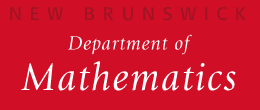Rutgers Math 138 – Calculus II for Biological Sciences
Nature of the Course
This course includes topics from differential equations and linear algebra that are useful in the Biological Sciences, topics which are not usually found in a second semester Calculus course. The course also gives an introduction to mathematical modelling of population growth, covering three mathematical models of population growth based upon: birth/death rates; limits to growth; and age distribution.
To include this material, the course excludes many topics that are needed in a third semester calculus course such as 251.
Math 138 is not a CALC2 equivalent course.
The only courses satisfying the CALC2 prerequisite are Math 152, 154, and 192. These are different versions of the second semester of the sequence Calculus for Mathematics and the Physical Sciences, a traditional second semester calculus course that prepares students for higher level mathematics courses. Students who may wish to take Math 251 should follow Math 135 with Math 152, not Math 138 (and not Math 136). This applies to students in certain programs in the Biological Sciences (in particular, Molecular Biology and Biochemistry), which require Math 251. More information on the transition from Math 135 to Math 152 can be found on the web page Mathematics placement advice.
Math 138 will not serve as a prerequisite for Math 251 or any other course requiring a CALC2 prerequisite, except Math 250.
In summary: If you intend to take higher level courses requiring CALC2, do not take Math 136 or Math 138; take Math 152 instead.
For a further discussion of Math 138, see What is this course?
Text and Syllabus
Since Spring 2014, this course uses CALCULUS Special Edition, Chapters 5-8,11,12,14 (Sixth Edition), by K. Smith, M. Strauss and M. Toda and published by Kendall Hunt (ISBN# 9781465240798). This is a custom edition for Rutgers University, extracted from the larger (and more expensive) text CALCULUS by Smith, Strauss and Toda.
The course also requires two supplements to the textbook:
- A Rutgers supplement, with two parts, on A. Population Growth Models and B. Linear Algebra.
- A UMAP Supplement, Population Projection, by Edward L. Keller. You will need a username and a password to access this material; they will be supplied to you in the lectures.
Fall 2019 Schedule
This course is not offered in Fall Semesters.
Current Semester
Materials used in Spring 2008
- Review Problems For The Final Exam
- Review Problem For The Televised Review
- Watch the televised review
- Formula Sheet For The Final Exam
Catalog Description
01:640:138. CALCULUS II
FOR THE BIOLOGICAL SCIENCES (4)
For biological sciences
majors.
Prerequisite: CALC1. Credit restrictions: CR2.
Techniques of integration, elementary differential
equations and their applications to biological sciences, and an
introduction to linear algebra.
Disclaimer: Posted for informational purposes only
This material is posted by the faculty of the Mathematics Department at Rutgers New Brunswick for informational purposes. While we try to maintain it, information may not be current or may not apply to individual sections. The authority for content, textbook, syllabus, and grading policy lies with the current instructor.
Information posted prior to the beginning of the semester is frequently tentative, or based on previous semesters. Textbooks should not be purchased until confirmed with the instructor. For generally reliable textbook information—with the exception of sections with an alphabetic code like H1 or T1, and topics courses (197,395,495)—see the textbook list.








